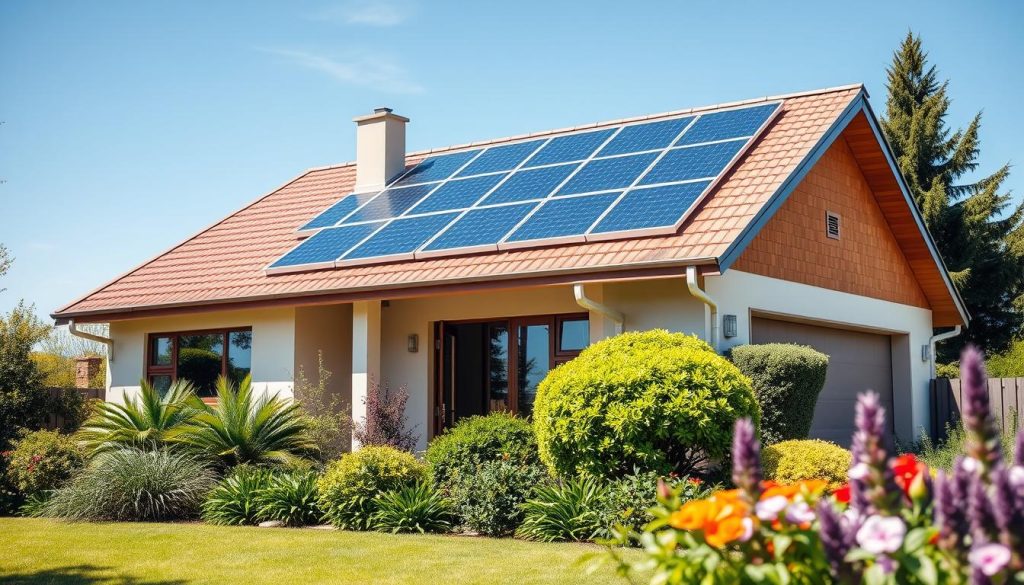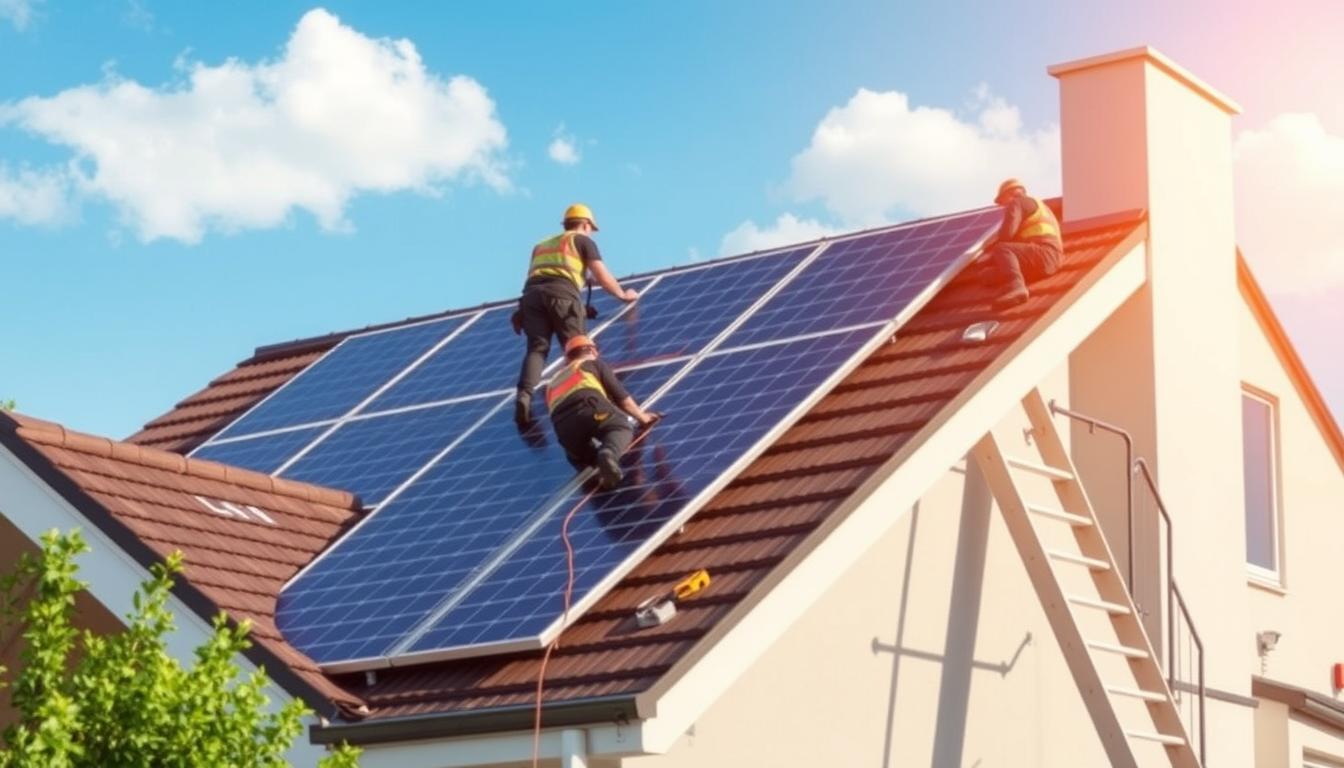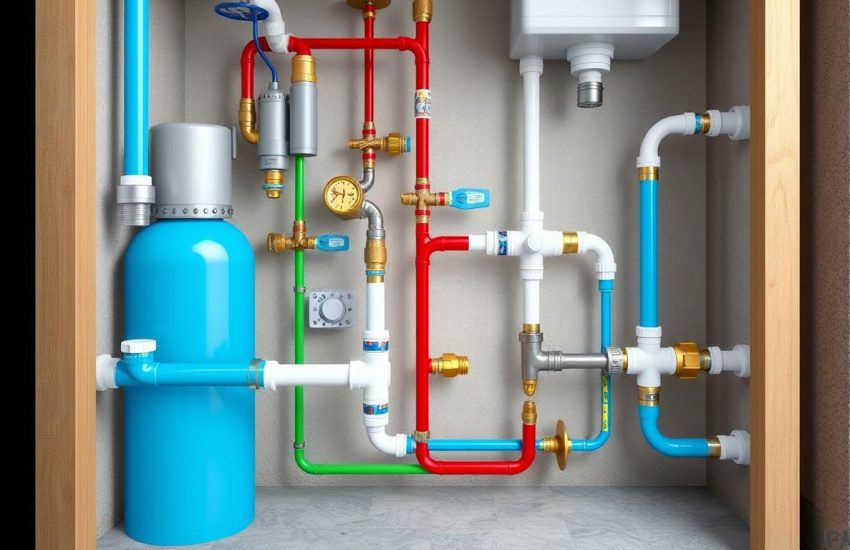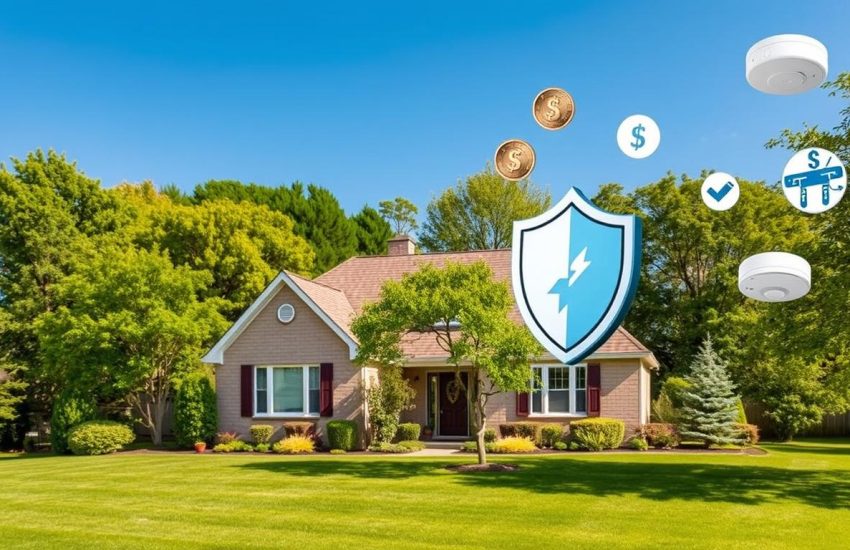Solar Panel Installation: A Complete Guide for Homeowners
Switching to solar energy is now both an eco-friendly and smart financial move. Costs for affordable solar panel installation have gone down. This makes it a good home improvement choice. Yet, how do you tell if solar energy fits your home well?
Many things decide if your roof is great for solar. Not every roof is right for it. Things like direction, slope, and shade matter. If your roof won’t work, community solar can be a good plan. It lets many people use solar power together.
EnergySage helps make going solar simple. They have a Community Solar Marketplace. The North American Board of Certified Energy Practitioners (NABCEP) also helps. They make sure skilled pros help you switch to solar.
Key Takeaways
- Checking if your roof works for solar panels is key to getting the most from solar energy.
- Lower solar panel costs make it a smart home improvement move.
- If rooftop panels aren’t an option, community solar is a good choice.
- Tools from EnergySage and NREL help those looking at affordable solar panel installation.
- It’s important to have your panels set up by NABCEP-certified experts.
Why Focus on Solar Panel Installation?
Looking into solar panel installation benefits shows a chance to boost your home’s value. It also gives economic and environmental perks. With improved technology and lower costs, homeowners see big savings and a smaller carbon footprint.
Learn more about solar benefits, from higher property values to being energy self-sufficient. Solar additions can increase home value by up to $15,000. This is great if you plan to sell in the future.
- Solar panels make clean energy, which helps our planet.
- They last about 25 years, offering long-term savings on electricity.
Solar energy brings economic benefits. Homeowners can save on solar panel installation through tax credits. These credits give back about 26% of the costs. Systems often pay for themselves in eight years. Over 30 years, you could see over 100% ROI.
If you make more energy than you use, selling it back to the grid is profitable. This adds to the financial benefits of solar energy.
Solar energy is now easier to get with community solar projects. These are great for people who can’t install panels themselves. It helps everyone access solar energy.
But, it’s key to see if your home is right for solar panels. The type of roof and its direction affect how well they work. Solar battery tech also helps use solar energy at night. Energy storage is getting cheaper and better.
In summary, switching to solar is good for the planet and your wallet. It protects you from changing energy costs. With more focus on renewable energy, it’s a good time to check out solar options.
DIY vs Professional Help
Choosing between DIY solar panel installation and professional solar panel installation depends on cost, efficiency, and safety. DIY projects can save you money upfront. But, professional help provides better long-term reliability and efficiency for your home energy system.
| Aspect | DIY Solar Panel Installation | Professional Solar Panel Installation |
|---|---|---|
| Installation Time | Varies based on individual expertise | 30% faster completion rate |
| Cost Efficiency | Up to 50% savings on labor costs | Higher initial costs but long-term savings through efficiency and fewer errors |
| Risk of Errors | 70% chance of significant installation errors | Minimized risk due to professional expertise |
| Safety and Compliance | Higher risk of safety incidents and non-compliance | 90% compliance with local codes; reduced safety risks |
Choosing between DIY solar panel installation and professional solar panel installation requires thought. Think about your skills and knowledge of local codes. DIY might cut initial costs. Yet, risks like not meeting standards and poor efficiency warrant attention. Professionals offer warranty protection, expert design, and ensure safety, making your home energy system investment safe and worth it.
DIY projects are great for those who want to be hands-on and save money now. But, professional setups offer more security. They ensure your solar power system works well and is safe. This brings real value to homeowners focused on reliability and efficiency.
How to Save Money
Today, everyone is talking about how to save money and help the planet. Affordable solar panel installation is a great answer for people who own homes. Using solar panels can save a lot of money in the long run. This includes using the solar investment tax credit and lowering utility bills.
The solar investment tax credit is a big help. It lets homeowners deduct 30% of solar system costs from their federal taxes. This makes solar panels more affordable. The average cost for solar panel setup is about $31,558 before any discounts. Knowing about these financial helps is very important.

Not many know that choosing Energy Star-rated appliances can also cut energy costs. These appliances need less power. So, they make the most of the energy from solar panels. This saves even more money. Also, there are financing options for solar panels. They often cost less per month than regular electricity bills. This means you start saving money right away.
For extra savings, look into state-specific benefits. States like New Mexico get a lot of sun. This means more energy from solar panels. Homeowners should learn about local incentives at places like the Database of State Incentives for Renewables & Efficiency (DSIRE).
Choosing solar power saves money and the environment. This is because of the solar investment tax credit and installation savings. Over 25 years, solar panels can save a lot of money. Many homeowners have saved thousands.
To find out more on saving money with solar, check out UMASolar. Learn about the financial benefits of solar energy there.
Step-by-Step Upgrades
Getting solar energy starts with a careful step-by-step solar panel installation process. First, experts check your home to see if it’s a good fit. They look at the roof to make sure it gets enough sun, which is key for energy system optimization.
Next, you pick the solar system type that fits your needs. It could be grid-tie, hybrid, or off-grid. For example, an 8 kW system is good for average homes. It uses about 900 kWh per month. You’ll choose between different panels and batteries for storage.
Then, it’s time to get the right permits and paperwork. This is very important because it follows local laws. You might need different permits, depending on where you live. After this, putting up the solar panels usually takes one or two days. Most of the time, you don’t need to be there.
After the panels are up, you have to keep them working well. Solar panel maintenance is a big part of this. It includes checking the system often and having a pro look at it once a year. Learn more about important home checks and when to do them.
- Routine cleaning of solar panels to prevent dirt and debris accumulation
- Inspection of solar inverters to ensure they function correctly
- Checking all electrical connections for potential issues
Also, it’s important to know how much it all costs. An 8 kW full-service can cost about $32,000. But, a DIY kit could save you over $10,000. Plus, there might be rebates or incentives to help you save more.

By following these steps and keeping up with maintenance, homeowners can save money. Plus, they help the planet by using solar power well. Start using the sun’s energy smartly and keep your home running smoothly for a long time.
Final Tips for Success
More people want to live sustainably these days. They’re setting up solar panels at home. It’s vital to learn about solar energy systems for a good setup. Consider your home’s layout, like the roof’s direction. A south-facing roof enhances solar efficiency by up to 15%.
Choose a trusted provider to harness solar energy well. Top companies like SunPower, REC, and Panasonic lead with excellent products. If you like tech, look for tools that check your solar panels’ work. This helps live an energy-smart life, even after your panels are up.
Being ready money-wise is key. Explore solar loans with no upfront cost. Learn about tax breaks and local perks too. Make sure your roof is in good shape for the long haul. Think about getting a battery backup and net metering to use extra energy. With good planning, professional help, and regular care, using solar energy can be smooth and fulfilling for many years.



